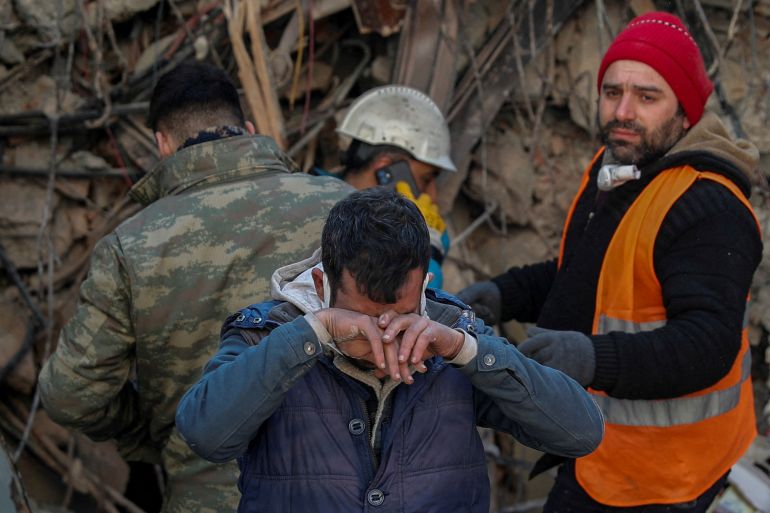‘Anger, sorrow, anxiety’: Healing scars of Turkey’s quake victims
Experts say psychosocial programmes should be implemented in the region to educate and help people cope with trauma and go back to routine life.

The massive earthquakes that struck southeastern Turkey and northwestern Syria on February 6 have not only caused death and destruction – but also deep trauma to the survivors.
In Turkey, where the death toll as of Monday has topped 41,000, government agencies and NGOs have been working hard to deliver much-needed humanitarian aid, including shelter, food and clothing.
Keep reading
list of 4 itemsTurkey to end earthquake rescue operations
Is Istanbul ready for a major earthquake?
After massive Turkey quakes, Istanbul residents fear the next one
At the same time, expert psychologists have headed to the quake-hit areas to help residents cope with the devastating impact of the magnitude 7.8 and 7.6 temblors.
Gokhan Malkoc is one of them. A professor of psychology at Istanbul Medipol University, Malkoc has been in seven of Turkey’s 10 affected provinces alongside colleagues as part of government efforts to set up psychosocial centres.
“Natural disasters create circumstances of uncertainties, which lead to certain feelings such as anger, sorrow and anxiety in people who experienced them,” he told Al Jazeera.
Malkoc said most disaster survivors stay in shock for several days after such an incident. This intense psychological state makes it hard for them to regulate their emotions, with their bodies adapting by creating certain physiological, behavioural and emotional reactions.
“Earthquake survivors might give abnormal reactions for a period of time and these abnormal reactions should be evaluated as normal after the shock since they cannot express their feelings in a healthy manner,” said Malkoc.
“An adult who wets their pants for no reason, cannot sleep or cannot enter closed spaces are some of such reactions on the extreme side we observed in the past among survivors.”
PTSD cases
According to data shared by Turkey’s Ministry of Environment, Urbanisation and Climate Change, the disaster affected some 13.5 million people in the country.
The ministry said that 84,726 buildings with 332,947 individual units either collapsed or were heavily damaged, leaving hundreds of thousands of people across the region homeless.
Malkoc said long-term initiatives with a psychological, social and legal focus should be implemented to help survivors of all ages understand the situation they go through and eventually return to their pre-quake life.
“These programmes educate people in different groups – such as children, teenagers, adults, men and women – and while helping them cope with the situation, they also scan the participants for cases that need professional psychiatric and psychotherapeutic help,” he told Al Jazeera.
Cigdem Yumbul, a psychotherapist with the Turkish Psychological Association who also visited the quake-hit areas, told Al Jazeera there was no need initially for one-on-one therapy sessions with most survivors, except for acute cases.
She noted that it was not just the people who were directly affected by the disaster who needed psychological support – but also those working in support of them, from rescue teams to health workers.
“Studies show that the vast majority of people who go through mass traumatic events such as disasters, if they have enough social and material support, they are able to heal from traumatic stress responses in six months to one year by using their own resilience capacity,” said Yumbul, adding that psychological first aid followed by group therapy sessions should be implemented in disaster areas to accelerate and help with this process.
“If individuals still show heavy symptoms of traumatic stress after [that] … then we provide individual psychotherapy.”
Experts say post-traumatic stress disorder (PTSD) is the most common condition seen in disaster survivors, as many witness their relatives and friends die or stay stuck under the rubble for days before being saved. In many cases, the uncertainty that comes with possibly losing their homes and businesses exacerbates the distress.
PTSD is a mental health condition that emerges after people experience or witness a terrifying event. The symptoms may include nightmares, flashbacks, uncontrollable thoughts and anxiety, as well as physical reactions such as sweating and a racing heart, among others.
According to Yumbul, people who suffer from PTSD stay alert to danger at all times and therefore have a hard time getting back to their routine life.
“Their bodies respond as if they are in constant danger, in a way acting in a survival mode, after the trauma they go through, while mentally healthy individuals would give similar responses merely in dangerous situations in life,” she said.
“Simply put, through certain techniques we use, we work to turn off this alarm button which stays constantly on after a great trauma.”
Children and education
Meanwhile, international charity Save the Children has warned that the mental health and wellbeing of seven million children in Turkey and Syria is at risk for years to come because of the catastrophic earthquakes.
It called for psychosocial and psychological support along with humanitarian aid across the earthquake-struck region.
The Turkish government said last week that the year’s second semester at universities nationwide will be carried out through distance learning, with the student dorms owned by the state to be used for the accommodation of earthquake survivors.
Primary and high-school students on Monday returned to on-site education across the country, with the exception of those in the provinces hit by the tremors. In these areas, schools will remain shut at least until March 1, but that date is likely to be extended.
Malkoc said a return to the classroom would be therapeutic for children in the quake-hit areas.
“It is best to start on-site education as soon as possible, after setting up container and tent towns and schools inside them, which would help rehabilitate children fast, or a model that can move students to other cities for education can be considered,” Malkoc said.
“Children and teenagers’ adaptation back to routine life in general is easier than adults after such traumas.”